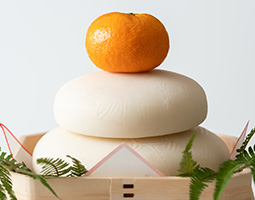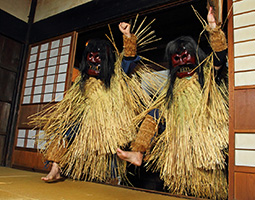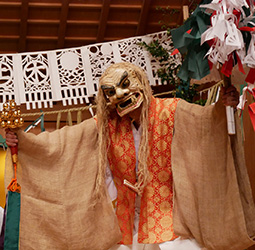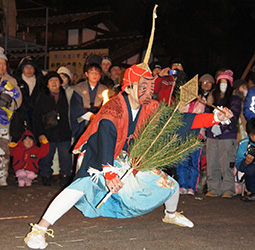February 2023
- English
- 日本語
Traditional Winter Events in Japan

Ogawa Naoyuki, a professor at Kokugakuin University 
Eho-maki sushi rolls

A mikan orange atop kagami mochi 
Oga no Namahage of Oga City, Akita Prefecture 
A kagura performance in Takachiho Town, Miyazaki Prefecture 
A dance impersonating a deity named Saiho at the Niino no Yuki Matsuri festival held at a shrine in Anan Town, Nagano Prefecture

We asked Ogawa Naoyuki, a professor in the Faculty of Literature at Kokugakuin University, about traditional winter events in Japan.

When do Japanese people perceive winter to be?
It depends on the region, but I think many people consider the period of low temperatures between December and February as winter. With the solar calendar currently used in Japan, the start and end of winter is not defined. But in the old calendar (lunisolar calendar)* used by Japan in the past, winter was determined to be from October to December with spring set from January to March. Winter in the old calendar equates to around the end of October to the middle of January in today’s calendar. Also, as a standard for the changing of the seasons, the nijushi-sekki** (Twenty-Four Solar Terms) used with the old calendar set winter as being from ritto (start of winter) on around November 7 in the modern calendar until the day before risshun (start of spring) around February 4. The season of spring begins on risshun, as the cold gradually eases up.
Annual seasonal events were held by people in Japan based on this old calendar and the nijushi-sekki. These traditions are still passed down today in homes and communities.
Please tell us about the events that are held in winter.
In Japan, a variety of events are held at the start of January for shogatsu (the start of the new year). For example, people decorate the entrances to their homes, apartment buildings, and company buildings with decorations for the new year, including kadomatsu and shimekazari, to welcome Toshigami-sama, a deity of the new year who brings happiness. Kadomatsu act as markers to welcome Toshigami-sama into the home, typically made with three bamboo stems of differing lengths surrounded by pine branches. Pine and bamboo are auspicious plants that represent long life. Shimekazari are meant to indicate a sacred place to welcome the Toshigami-sama deity. There are a variety of shapes, but one example would be a sacred rope made of rice straw with a long, white paper called a shide hanging down from it. Some people also decorate with kagami mochi rice cakes as an offering to Toshigami-sama. Kagami mochi usually comprise two pieces of dried and hardened round mochi stacked on top of one another.
In the old calendar, the time around the full moon on January 15 was called koshogatsu (the little new year), and in this season, events were held in farming and fishing villages to wish for a bountiful catch and harvest for the year. For example, tori-oi is an event in which children walk from house to house in their town singing a song to drive away harmful birds that damage crops. By driving away harmful birds at the start of the year, people hope to avoid damages during the actual farming period. Some people attach small, round red and white mochi called mochibana (mochi flowers) to tree branches as decorations. These are considered to resemble rice stalks and silk cocoons. There are also regions in Japan that hold dondo-yaki, where new year’s decorations are burned to ward off disaster (see here). Dondo-yaki is said to originate from sagicho, a ceremony to burn kissho, or documents used in rituals, on January 15, which started in the imperial court during the Heian period (late 8th century to late 12th century).
What kinds of foods are eaten at winter events?
Rice has been the most important food for Japanese people since ancient times. Many traditional events were held to pray for a bountiful rice harvest. That is why food made with rice is often eaten at traditional events. For example, mochi is generally eaten during shogatsu. It is thought that by eating mochi, you receive power from Toshigami-sama. Zoni is another food eaten during shogatsu. It is a soup flavored with soy sauce or miso and filled with vegetables, mochi, and other ingredients. And on kagami-biraki on January 11, though the date differs according to region, the kagami mochi that was used for decorations is broken and eaten, such as by putting it in shiruko, a soup of boiled red beans and sugar.
During setsubun held around February 3, the day before the start of spring, mamemaki is performed, where beans are thrown to ward off disaster. On this day, eho-maki is eaten. This is a roll of sushi rice filled with egg, cucumber, and other ingredients wrapped in seaweed. It is said that if you eat this sushi in silence without cutting it while facing the eho, or direction that is deemed good for the year, you will have a good year, your wishes will be granted, or you will be in good health.

What kinds of traditional performing arts are performed in winter?
One example would be kagura*** dedicated to the deities. There are around 4,500 kagura groups in Japan today. For example, there are more than 200 groups in Miyazaki Prefecture, and a variety of types of kagura have been passed down by local residents. There are also nearly 300 groups in Hiroshima Prefecture where the G7 Summit will be held this year in May, and many groups actively hold public performances.
Some of the groups perform publicly year-round at shrines and other venues. However, kagura was originally performed mainly in winter. It is thought that kagura originated as a part of the mitamafuri ritual held in November in the imperial court from the 10th century. As our energy weakens during this season of shortened daylight hours, it was believed that through kagura, people could be energized by the power of the deities to get them to the year’s end. Kagura later spread across Japan from the 13th century. It is also thought that as it spread, it came to be performed in other seasons to pray for an end to disease and for a bountiful harvest.
Dengaku is another traditional winter performing art to invoke a bountiful rice harvest. There are some forms of dengaku where women sing and dance to an accompaniment of traditional Japanese flute and drum while actually planting rice during the rice-planting season in spring, but winter dengaku only mimics the work of planting rice. For example, Itabashi no Ta-asobi has been passed down in Itabashi City, Tokyo, and it is a form of dengaku that depicts a year’s rice cultivation through words, songs, and movements. In Nishiure no Dengaku from Hamamatsu City, Shizuoka Prefecture, dengaku, kagura, noh, and a variety of other performing arts are performed all night long, from moonrise to sunrise. All of these examples of dengaku are designated as Important Intangible Folk Cultural Properties of Japan.
New year’s eve, new year’s day, koshogatsu, and other events held in winter are found among the events for raiho-shin deities inscribed as “Raiho-shin, ritual visits of deities in masks and costumes” in UNESCO’s Representative List of the Intangible Cultural Heritage of Humanity. In these events, people wearing bizarre masks and impersonating raiho-shin deities visit homes, pray for a good harvest, ceremoniously cleanse evil, and persuade children to be good people. Some examples include the Koshikijima no Toshidon of Satsumasendai City, Kagoshima Prefecture, the Oga no Namahage of Oga City, Akita Prefecture, and the Noto no Amamehagi of Wajima City, Ishikawa Prefecture.

Are there any regions to pay special attention to in regards to traditional winter performing arts?
Miyazaki Prefecture is active in preserving and passing on kagura traditions. Kagura is held at night from November to January in Takachiho Town and other parts of northern Miyazaki Prefecture, and performances are also held from February to May during the day in central and southern Miyazaki, including Miyazaki City. The most appealing aspect of Miyazaki Prefecture’s kagura is its diversity. Unique kagura in each region are passed down.

The Minami-shinshu region in southern Nagano Prefecture is also an active area for kagura, dengaku, and other traditional performing arts. For example, during the Toyama no Shimotsuki Matsuri festival held in Iida City in December, kagura is dedicated at shrines by offering hot water boiled in iron pots to the deities. During the Niino no Yuki Matsuri festival held at shrines in Anan Town in mid-January, a variety of performing arts, including dengaku praying for a bountiful harvest, are performed throughout the night.

An important feature of these prefectures’ efforts is the fact that local governments, companies, and residents work together to preserve and pass on local traditions. Miyazaki Prefecture and the Minami-shinshu region have established systems to encourage workers to take time off to participate in and appreciate traditional performing arts.
Regions across Japan are facing the issues of declining birthrates and an aging and shrinking population. In rural areas, it is important to maintain personal connections to create sustainable local communities. Kagura and other traditional performing arts play a major role in this. People of all ages participate, from children to seniors. These performing arts are an opportunity to connect people from a variety of generations.
I hope that overseas visitors coming to Japan in winter will see the kagura and dengaku unique to each region. Performers’ movements, practiced over many long hours, are truly beautiful. I am moved to tears by the sight of people dancing for themselves, for those in the community, and for the deities.
* The old calendar (lunisolar calendar) was created based on the cycles of the waxing and waning of the moon (29.5 days) and the sun, and it was used in Japan until 1872. A leap year of 13 months was set up every two or three years. There is about a one month difference between the old calendar and the modern calendar.
** Devised in ancient China, the nijushi-sekki (Twenty-Four Solar Terms) divides the year into the 24 segments of the sun, giving names to seasons once every 15 days or so.
*** For more about kagura, dengaku, and other traditional Japanese performing arts: https://www2.ntj.jac.go.jp/dglib/contents/learn/edc27/en/index.html

